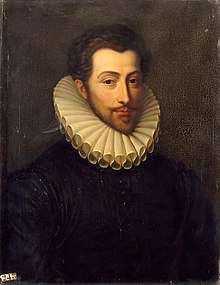Louis de Bussy d'Amboise
Louis de Clermont, seigneur de Bussy d'Amboise (1549–1579) was a gentleman at the court of French king Henri III, a swordsman, dandy, and a lover of both sexes. He was one of the favourites, or "mignons", of Monsieur, brother of the king.[1] He was a cousin of François d'Amboise.

Of a noble family (his great-uncle was a cardinal), he entered the service of Prince François, Duke of Anjou, the younger brother and rival of Henri III. Bussy became well-known at court as Anjou's "favourite" and later became the lover of Princess Marguerite de Valois.
"Le brave Bussy" made fun of the favourites of the king and frequently fought duels with them. He helped Anjou flee from the court where Henri III held him prisoner.
He was a main participant in the St. Bartholomew's Day massacre (1572).
He soon fell in love with the wife of seiguer De Montsoreau. He was badly wounded after fighting with 20 men, sent by seiguer De Montsoreau. He was then killed by Anjou because he himself loved the wife of seiguer De Montsoreau.
In popular culture
Bussy d'Amboise is the hero of the play Bussy D'Ambois (1607) by English playwright George Chapman, written 20 years after d'Amboise's death. He is also the hero of the novel La Dame de Monsoreau by Alexandre Dumas, père.
David R. Slavitt featured d'Amboise in his 2011 novel The Duke's Man.
Notes
- Régistre-journal d'un curieux etc. pendant le règne de Henri III: 1574-1589 by Pierre de L'Estoile, Jean-Jacques Champollion-Figeac; p. 93